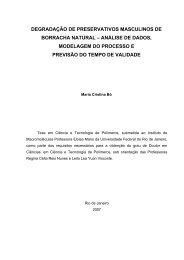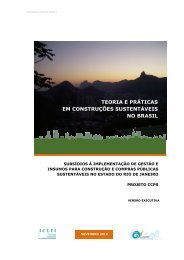A New Method for Protein Hydrolysis with Crystallized . Oxalic Acid
A New Method for Protein Hydrolysis with Crystallized . Oxalic Acid
A New Method for Protein Hydrolysis with Crystallized . Oxalic Acid
You also want an ePaper? Increase the reach of your titles
YUMPU automatically turns print PDFs into web optimized ePapers that Google loves.
A <strong>New</strong> <strong>Method</strong> <strong>for</strong> <strong>Protein</strong> <strong>Hydrolysis</strong> <strong>with</strong><br />
<strong>Crystallized</strong> <strong>Oxalic</strong> <strong>Acid</strong><br />
The well known disadvantages of the conventional methods of protein<br />
hydrolysis prompted us to try "dry heating" of the protein <strong>with</strong> crystallized<br />
oxalic acid as hydrolyzing agent. This acid, already employed in the pyrohydrolysis<br />
of organic substances by FEIGL[1],was never tried be<strong>for</strong>e as a specific<br />
agent <strong>for</strong> breaking up the peptides bonds. Although LIEKENET AL.[2]observed<br />
a large carbonization and small cleavege of the protein by dry heating <strong>with</strong><br />
monochlor acetic acid or <strong>with</strong> o-chlor benzoic acid, oxalic acid proved to be<br />
an effective and useful hydrolyzing agent.<br />
The protein used in all experiments was a purified commercial grade<br />
of casein; the amino acids standards were obtained from Mann Research<br />
Lab., Inc.<br />
Troll and Cannan's reagents [3] were used <strong>for</strong> the ninhydrin reaction<br />
and the <strong>for</strong>maldehyde titration was per<strong>for</strong>med according to the Dunn and<br />
Loshakoff technique [4].<br />
The hydrolysis was followed by paper electrophoresis using a pH 5 O.lM<br />
pyridine-acetic acid buffer.<br />
Casein and the hydrolysing agent were mixed, in the desired proportion,<br />
ground and transferred to test tubes. Some of these tubes were sealed prior<br />
to hydrolysis. After a certain time of heating in oil bath, at 120°C, the tubes<br />
were cooled and the reaction products dissolved in water. It was observed<br />
that the mixture in the open tubes turned liquid after 15 minutes and remained<br />
liquid even after 6 hours of heating, after which it solidified. In the sealed<br />
tubes it remained liquid even after 24 hours of heating. After the reaction<br />
the sealed tubes had to be cooled in a dry ice-acetone mixture be<strong>for</strong>e being<br />
opened. This was necessary to avoid the violent explosions of these tubes.<br />
For the subsequent tests it became necessary to eliminate the acid,<br />
and the best result was obtained by utilyzing powdered CaC0 3 • This has<br />
the advantage of not increasing the volume of the liquid to any considerable<br />
extent, and when used in excess, remains insoluble. Other methods of eliminating<br />
the oxalic acid, such as ion-exchange resins were also tried giving, however,







![ABM 2012 Torquímetros 20801[1].pdf - INT](https://img.yumpu.com/35773768/1/184x260/abm-2012-torquimetros-208011pdf-int.jpg?quality=85)





![Resumo biodiesel 2012 Raquel Rev cla[1].pdf - INT](https://img.yumpu.com/27723744/1/184x260/resumo-biodiesel-2012-raquel-rev-cla1pdf-int.jpg?quality=85)


